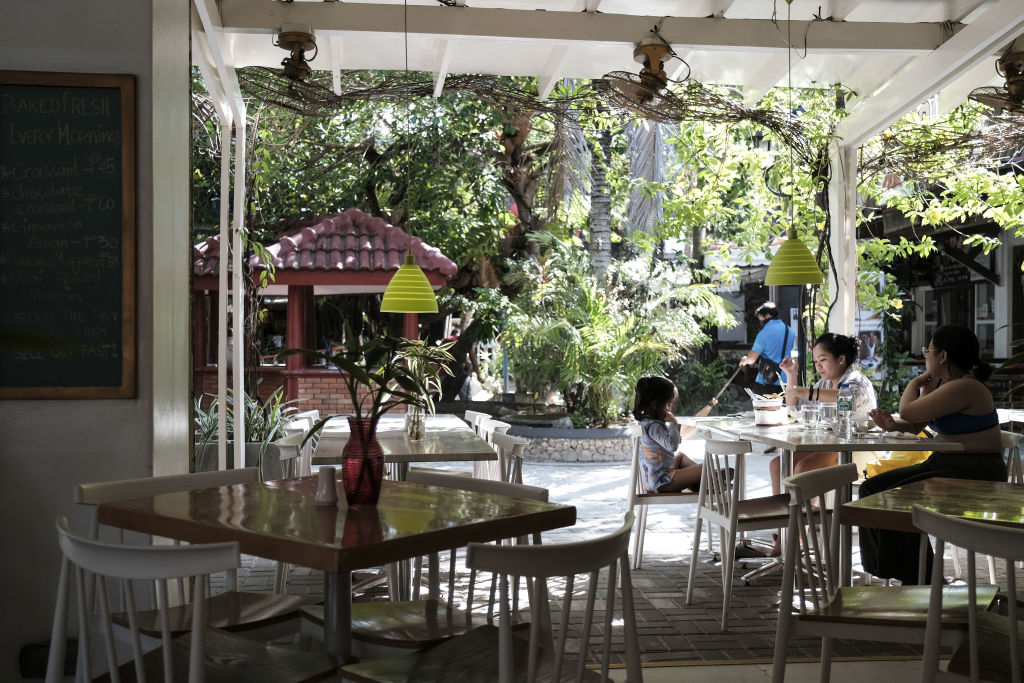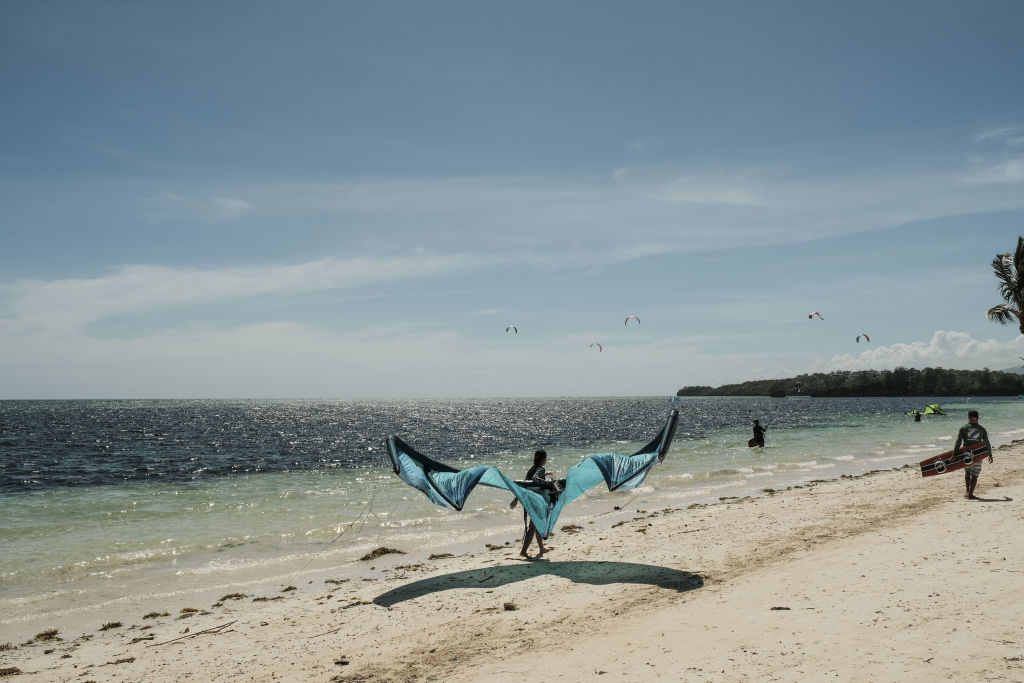
Boracay is among the finest of the 7,641 Philippine islands and, for a long time, was one of the least known, its four square miles a closely guarded secret. Sequestered in the center of the archipelago, the island’s pristine beaches and gin-clear waters were the refuge of the handful of native Ati inhabitants—until the rest of the world caught on.
Too Late the Hero, a 1970 American war film shot on Boracay with big name stars Michael Caine and Henry Fonda, is credited with sparking international interest in the stunning location. The ensuing trickle of curious backpackers became a flood in 1979, after a German travel author, Jens Peters, published his definitive Philippines Travel Guide and proclaimed Boracay a “paradise.” Just over a decade later, the Tropical Beach Handbook—a Michelin-style compendium sponsored by automaker BMW—hailed Boracay beach as the best in the world.
Naturally, such recognition came at a price. From a community that didn’t even have electricity until 1992, Boracay rapidly turned into an international party hub, its shoreline crammed with dusk-till-dawn bars and clubs.
In 2019, the year before the pandemic brought travel to a halt, some two million tourists visited Boracay, pumping around $1 billion into the tiny island. But over the years, tourism also generated enormous problems, particularly with garbage and sewage disposal. Raw sewage was being pumped into the sea and broken glasses, bottles, and plastic cups littered the shoreline. Things got so bad that President Rodrigo Duterte called the island a “cesspool” and banned tourists for six months in 2018 so that a cleanup could take place.
Read More: What to Do If You Test Positive for COVID While Traveling
Today, because of the pandemic, the island is once again mostly free of foreigners. According to local government figures, less than 5,000 of the 200,000 visitors to Boracay in May were from overseas. Their absence has altered the nature of the island completely. Bars close as early as 9 p.m. and money changers don’t even bother to open—because almost everyone you see on Boracay these days is from the Philippines.
Some, like Cedrick Ungab, are enjoying their country’s most popular island for the first time. The tourist from Manila had heard all about Boracay’s infamous nightlife before he visited six months ago. But upon arrival, he realized that he liked the quiet. “It had more of a family vacation vibe,” Ungab tells TIME.

Local tourists and Boracay
What is happening in Boracay is being replicated in many other Asian tourism hotspots still emerging from the pandemic. Inbound, long-haul travel is gradually resuming, but it is an onerous business, involving multiple PCR tests, varying degrees of quarantine, costlier flights on reduced schedules, and a complex, ever changing web of regulations and paperwork. To get to Boracay, vacationers must submit proof of COVID-19 vaccination and a hotel booking three days before their trip. They are then assigned a QR code, without which they will be denied entry.
When COVID-19 hit, the island was left scrambling for visitors. International travel companies and eateries shut down, and island residents working in the tourist trade had to look for other jobs, with many relying on pandemic aid from the local government. One travel assistant says he took up construction work and fishing to make ends meet. Mary Grace Malolos, who has a wholesale seafood business, says her venture has earned nothing in the past year and a half.
Because of stringent COVID regulations, it was not until October last year that the island saw a steady stream of visitors again. The dearth of partying foreigners left a gap that domestic holidaymakers were all too eager to fill.
Read More: Why Business Travel’s Demise Could Have Big Consequences
Philippine vacationer Natalia Chan tells TIME she was reluctant to take an overseas holiday because of the risks and hassles associated with cross-border travel during the pandemic—so she went to Boracay in March. What she saw was refreshing and relaxed. The island was free of crowds, with most attractions within walking distance. There was room in the streets and little alleyways to explore shops and eateries in an unhurried manner. The usual beachside touts were there, offering kayak rides, hair braiding, or temporary tattoos, but they advertised their services in the local tongue instead of English.
Many of the island’s 4,000 licensed businesses have nimbly adjusted to the change in customers. Cris Cahilig manages a hole-in-the-wall burger joint called Two Brown Boys, which used to cater to international travelers. Now, over 95% of her clientele is local. “We had to pivot to stay in business,” she says. “We added rice bowls to the menu and started offering breakfast.” She also put on a Filipino DJ, who knew what tunes the new customers wanted to hear.
Chan loved the island so much she stayed for a month and wishes that Boracay could remain as it is right now. While acknowledging the economic necessity of bringing foreign visitors back, she says “Honestly, I’d really like it to be our [island] because it is ours.”

Foreign tourism in the Philippines
Foreign tourists were only permitted in Boracay from February this year, and they have been returning in slowly increasing numbers, but visitors from the two biggest markets—South Korea and China—are thin on the ground, especially the latter. China’s zero-COVID policy deters residents from traveling overseas because of the onerous re-entry requirements they face on their return.
Before the pandemic, the island made efforts to lure the 1.9 million South Koreans and 1.7 million Chinese who visited the Philippines annually. Hotel signage and menus are commonly written in Chinese and Korean scripts. There are hopes for a revival of the South Korean market with the resumption this month of direct flights from Seoul’s Incheon Airport to Kalibo Airport, the main transportation hub for Boracay, about 75 kilometers from the island. But for now, the Chinese seafood restaurants and Korean BBQ joints lining the main streets and alleyways are still empty.
Janice Bindolo, the owner of a backpacker’s hostel, tells TIME the only Chinese and Koreans she sees are restaurant proprietors or fellow hotel and hostel owners. Most of her guests are locals or from Europe.
Read More: Can Barcelona Fix Its Love-Hate Relationship with Tourists?
M.J. Salme, marketing manager of the family-owned Pig Out Bistro, says that although international tourists are still scarce, the few who do visit the restaurant keep her “inspired and hopeful” for the island’s full comeback. “We are optimistic that after a few months, we will be expecting more international tourists to fly in,” she tells TIME. “We can’t afford another lockdown since we all have endured so much already during the pandemic.”
It’s clear, though, that many domestic vacationers would be happy if Boracay did not return to being the overcrowded, rubbish-strewn, rampantly commercial tourist trap it once was.
Says Chan, the holidaymaker who stayed a month: “I’m happy that Filipinos can enjoy it more [and] can travel there and enjoy the island as Filipinos.”
More Must-Reads from TIME
- Why Biden Dropped Out
- Ukraine’s Plan to Survive Trump
- The Rise of a New Kind of Parenting Guru
- The Chaos and Commotion of the RNC in Photos
- Why We All Have a Stake in Twisters’ Success
- 8 Eating Habits That Actually Improve Your Sleep
- Welcome to the Noah Lyles Olympics
- Get Our Paris Olympics Newsletter in Your Inbox
Contact us at letters@time.com